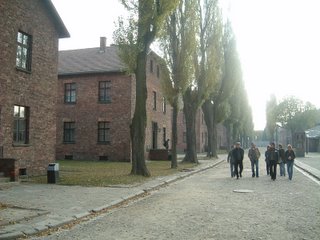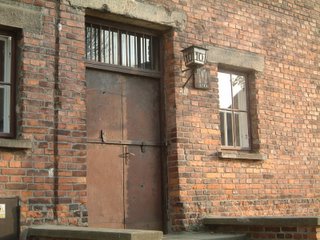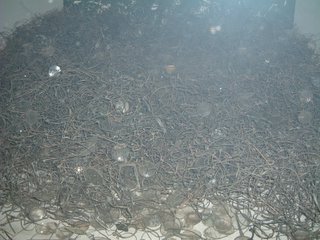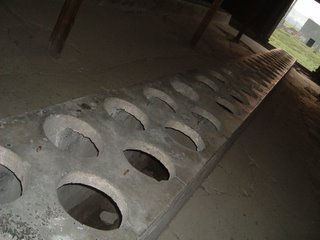Today, Poland once again honored the 6 million victims of the Holocaust with the Walk of Remembrance. Shimon Peres, the former Israeli prime minister and Nobel peace laureate, led 8,000 people, mostly students, in the annual March of the Living, a two-mile trek from Auschwitz to the larger, neighboring camp at Birkenau. Just like the events of 9/11, the world ought not to forget the devastation that a well-organized horror machinery brought upon a continent. Here are my impressions - after visiting the infamous place - which I shared in this site last February. 
Oswiecim
From Krakow (Poland), driving through beautiful fields, along country roads with fruit trees lining the sides of the roads, one eventually arrives at the most infamous place in
the world...a pleasant little town called Oswiecim about an hour away from Krakow, where the railroad system was so efficient, it was a hub for all rail transport from Europe and beyond... Right in the town, there is a typical red-bricked conglomeration of 18th century buildings that had been used as a military garrison by the Austrians, when they ruled this part of the world. The buildings once upon a time housed soldiers, eating halls, recreation facilities, and the erstwhile jail. The effect of visiting this place is very strange. I have been there on a glorious Autumn day, and on a snowy dark Winter day. The regimental beauty is palpable... In many ways, the red bricks and the climbing ivy on some buildings give the place the feeling of a school of sorts.
But the place is dead. A bird may sing, but you can’t hear it. The sun may be warm, but you don’t feel it. Door 10 leads to the rooms where Mengele experimented on the little twins. He had a warm life in Paraguay and Brazil...he drowned while going for a swim as an old man. The twins he cut up and sewed together as Siamese twins were not so lucky. Mengele’s bloc.

There’s not that much to see in these buildings. They are mostly empty now. In fact, the Holocaust Museum in the US has more memorabilia than Auschwitz.
Walking from one building to another, or from one room to another, you get a sense of what Hannah Arendt used to refer to as the “banality of evil”. The room full of suitcases, big ones and small ones, looking so old-fashioned... Then you move on to see

another room with a collection of what at first I thought were doll parts... But no, oh no, not wooden doll parts... These were the wooden arms, legs, hands, feet, prosthetics, back braces, orthopedic shoes, of those who carried those suitcases. For a second, I thought of my Father, who had to wear one of those orthopedic shoes when he was a boy.
Next stop: a gigantic skein of wires... wait, no, these are wire eyeglasses, a few monocles, all intertwined, thousands and thousands of them, big and small, all the same dull gray metal...and they all belonged to those who carried those suitcases.
 Turn around, and you are hit by a wall of hair. Well, we all heard that those who carried those suitcases were shaved, to delouse them.
Turn around, and you are hit by a wall of hair. Well, we all heard that those who carried those suitcases were shaved, to delouse them.  Oh, but all this hair we hear has traces of the Zyklon B gas... mmm... the dead were also shaved. Who would have ever thought that you can make burlap, and reams of it, out of human hair?
Oh, but all this hair we hear has traces of the Zyklon B gas... mmm... the dead were also shaved. Who would have ever thought that you can make burlap, and reams of it, out of human hair?
The Germans meticulously saved everything that belonged to those who carried those suitcases.
Of course, the red-brick garrison (which, initially, had been used to keep Polish political prisoners) soon outgrew its functional capacity, and the Germans applied their engineering ingenuity a few kilometers away.
It only takes one look at the efficient animal stalls that they erected,  together with a super-sized commode to sit 100, to understand that hell was right here for those who carried those suitcases.
together with a super-sized commode to sit 100, to understand that hell was right here for those who carried those suitcases.
Birkenau, or Auschwitz II, is where all the Jews from the Terezin Ghetto in Prague were sent.
Terezin is also known for the devastating loss of children… Among the many who perished in Auschwitz and other extermination camps after having “transited” in Terezin was Peter Ginz, an 11-year old boy, who drew his vision of travel in space in the early 1940’s. Ironically, his colorful drawing survived him; it eventually ended up in the national museum in Israel.
It was this particular drawing that Ilan Ramon, the Israeli astronaut who died in the Columbia shuttle accident, took with him on his fateful journey. More than 50 years after this boy’s life was snuffed, his own drawing was destroyed in an overwhelmingly dramatic accident, a fitting tribute the boy’s violent death! Amazingly, the shuttle flight happened on February 1, 2003: Peter Ginz would have celebrated his 75th birthday.
The crematoria did not appall me the way I thought it would. I guess it is because by then, most of the victims had been relieved of their suffering (I say most, because a few were cremated alive).
I never realized that the Zyklon gas was soaked in re-usable pellets. It took those efficient Germans a few times to figure out how much gas they needed per capita, so that, on their first try (on Polish and Russian prisoners) it took them 3 days to kill them all.
Earlier in 2005, when I visited another bastion of evil, Eagle’s Nest near Salzburg, one of the descriptions of the history of the construction of Eagle’s Nest was that most of the buildings carefully designed by Albert Speer, were built by Polish, Russian, Hungarian construction workers...the implication being that these were your average foreign construction workers and not the slave laborers that they were.
In 2003, touring Caen in Normandy, France, the museum there displayed the uniforms of the fighters during the Normandy invasion: the British uniform, the American uniform, and the German uniform, with no description of who was the enemy in the fight, a case of political correctness gone amuck... I guess one’s freedom fighter is another one’s terrorist... In the end, just put the uniforms together...who cares who defended what...they all fought, and there’s no difference... Yeah, go tell that to the Poles!
The Caen memorial was quite eloquent. But, it was a shock to discover that the European PC (politically correct) attitude had permeated the memorials for World War II: the display depicted the Germans not as the enemy but as other warriors… despicable… but predictable, I guess. More than 2 years later, I came across the following article, which, unfortunately, confirmed my original gut reaction!
Museum to D-Day fails to mention the warThe Times (UK) ^1/27/06 Adam Sage
THE museum set up by the French authorities to commemorate the D-Day landings is struggling under a mountain of debt amid a sharp decline in the number of visitors.
The Memorial Museum in Caen, Normandy, has been accused of mismanagement for turning its back on the Second World War to concentrate on subjects from feminism to Father Christmas. In recent months the museum has focused efforts on transforming itself into a “place of reflection on the contemporary world”.
“It’s ridiculous,” said Claude Quétel, who was sacked as the museum’s chief historian last year after protesting that it had fallen victim to political correctness. “The vocation of this place was to become the great museum on the Second World War in France. It’s drifting away from that idea, and it’s a dramatic error.”
In the grounds, for instance, are gardens created as a homage to the British, Canadian and American soldiers who lost their lives “so that freedom could triumph”.
But the museum’s brochure talks in pacifist tones of the need to “combat the violence around us . . . Peace begins at home, in the office, with our neighbours.”
“It is bizarre,” said Alain Chesnel, who runs tours of Normandy battlefield sites for American visitors. “I don’t advise people to go there. They should be retracing a page of our history, not presenting exhibitions that have absolutely nothing to do with it.”
Opened by François Mitterrand in 1988, Le Mémorial de Caen was designed to commemorate the Second World War, and notably the Battle of Normandy, in which 53,000 Allied troops lost their lives. The late French President described the museum as an “act of vigilance, confidence and hope”.
“But there was an ambiguity because it was officially called a Museum of Peace and told to look at the whole of the 20th century and not just the war,” said M Quétel. “That’s where the problem comes from.”
In 2002 the museum, which is run by Caen town council, opened a €13.72 million (£9.4 million) extension that includes sections on “the principal disorders in the world today” and the need for “eco-responsibility”. Stéphane Grimaldi, who was appointed director in October, said that it had lost €400,000 when the number of visitors fell to 400,000 from 560,000 in 2004, the 60th anniversary of D-Day.He announced cost-saving measures, including cuts to the guided tours of the D-Day landing beaches. His rescue plan includes exhibitions on Living without Petrol and on Father Christmas. M Quétel said: “I think they are turning their backs on the war and that’s a shame.”
[Auschwitz][Jews][Germany][France][Caen][Oswiecim][Holocaust] [Poland]
[Poland]



 Turn around, and you are hit by a wall of hair. Well, we all heard that those who carried those suitcases were shaved, to delouse them.
Turn around, and you are hit by a wall of hair. Well, we all heard that those who carried those suitcases were shaved, to delouse them. 












